On Saturday night, the Oregon Department of Transportation installed sharrows and new signs on the St. Johns Bridge. Their “St. Johns Bridge Safety Awareness Project” was done in order to, “encourage motorists to be aware that the bridge and roadway is a shared facility and that bicyclists may opt to travel on the roadway.”
They have placed eight sharrows in each direction, as well as adding two new “Bicycles on Roadway” signs mid-span. They also moved an existing sign at the westbound entry to a more visible location because it was partially blocked by a speed sign.
I rolled out to see everything myself this morning. My impression is that, while it’s nice to see ODOT acknowledge the bike access problems on this bridge, these sharrows and signs do not make this a more pleasant place to ride. Then again, that was not ODOT’s mission. As the name of the project implies, the new markings and signs will only increase awareness that people have the legal right to ride bicycles on the bridge. That’s helpful, but it’s a far cry from what should be the ultimate goal — to make the bridge a more viable (and less stressful) option for people on bicycles.
As I stood on the sidewalk to snap photos, massive trucks boomed by at well over 30 miles an hour (the speed limit is 35 mph, above which Oregon’s unsafe passing law goes into effect). The bridge shook beneath my feet and the sound pierced my ears. I usually ride this bridge on the weekend, when traffic (especially big trucks) is much more tame. I have taken a lot of photos while biking in traffic over the years, but I seriously considered aborting my mission this morning.
Against this intimidating backdrop of four lanes of roaring engines, sharrow markings look a lot different than they do on a quiet residential street.
To actually make the St. Johns Bridge a place where more people would consider bicycling, the solution would be to have a protected bike lane and one standard lane in each direction. That was actually the recommendation made by consultants David Evans & Associates, who studied the bridge in 2003.
“Result of traffic operations analysis in 2002,” read DEA’s St. Johns Bridge Transportation Impacts report (PDF), “indicates no capacity constraints or operational flaws on the bridge that would prohibit the implementation of any of the striping options.” Even in 2020, the report found that the only bottlenecks that would occur would be at the signalized intersections on each end.
Despite this study, and despite some advocacy by the Bicycle Transportation Alliance and others, ODOT caved to the freight lobby and left the lanes as-is. Hopefully, this small step by ODOT is just the start of a new conversation.
There wasn’t any other bike traffic this morning that took the road (I saw two people up on the sidewalk), so I couldn’t judge how people in cars behaved around the new markings.
Check out a few more photos below…

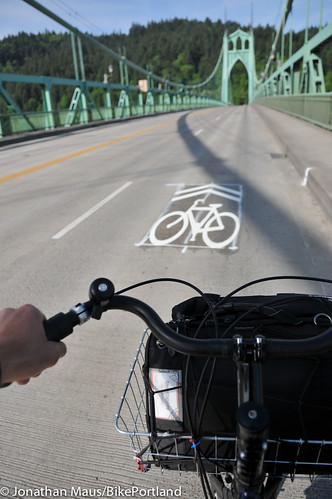
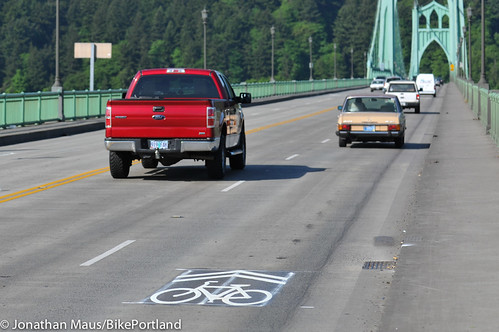
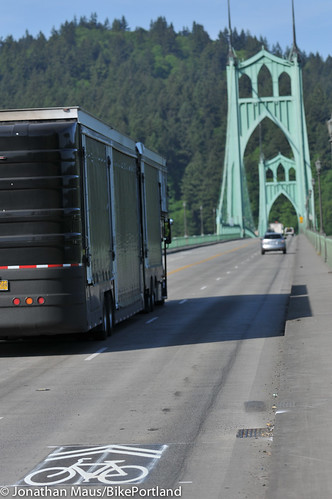
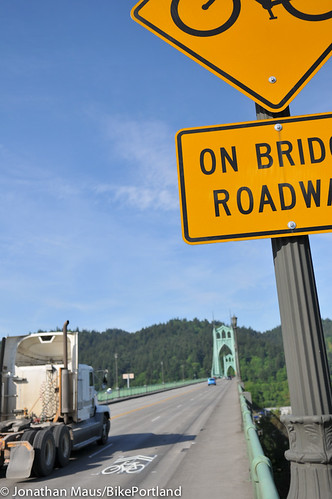

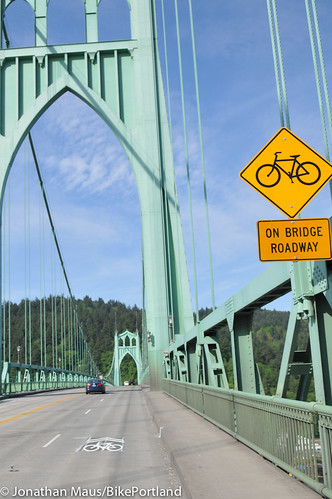
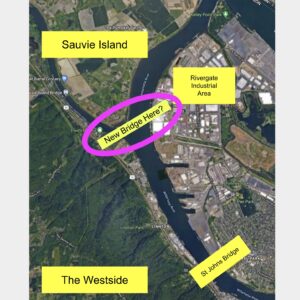
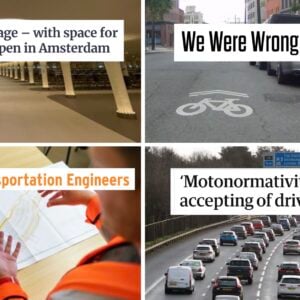
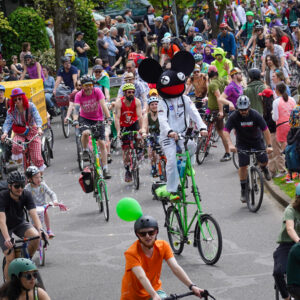

Thanks for reading.
BikePortland has served this community with independent community journalism since 2005. We rely on subscriptions from readers like you to survive. Your financial support is vital in keeping this valuable resource alive and well.
Please subscribe today to strengthen and expand our work.
I noticed the sharrows as i crossed the bridge via the sidewalk on sunday and i doubt they’ll change my crossing habits in the future (although, I do use the roadway on the way back since the downhill is longer). what struck me is how the size of the bridge/lanes, traffic and speed of the traffic minimizes the impact of their presence. they seem really insignificant.
What’s inviting about that part of NW if you’re bashful about traffic? A narrow sidewalk with frequent pedestrian conflicts certainly doesn’t hold any appeal to me.
From the beginning of the coverage here at bikeportland about ODOT’s decision to apply designate the right lanes of the bridge as sharrows using the pavement symbols and signs, I never expected that treatment would accomplish much real improvement to usability of the bridge by bike traffic.
I also have notice bikeportland’s publisher-editor Maus characterize ODOT’s decision not to designate the right lanes of the bridge deck as having “caved” to freight interests, without having provided any substance to support that characterization. First of all, what is “caved” supposed to mean here?
There seems to be rumors flying around that the freight industry applied some sort of pressure onto ODOT officials to have them make a decision that would keep bike lanes off the bridge deck, but absolutely nothing I recall reading here at bikeportland that gives those rumors any particular credibility.
The studies maus refer to suggest only that a bike lane configuration to the bridge deck would not have contributed to increased traffic congestion on the bridge. It doesn’t indicate ODOT’s reasons for retaining the two main lane configuration for the bridge. How about an actual statement from ODOT officials about their reasons for retaining that configuration? That could help to provide a working basis that would possibly allow arrangements to be better made for eventually installing bike lanes and reduced posted speed limits on the bridge.
wsbob,
It was clear there was opposition to a new lane config. from freight folks at the time this was being discussed. I have heard this from people involved with the discussions. Also, when I asked ODOT director Matt Garrett about it last month (he was in charge of the project), he made it clear the freight industry played a role. When I asked what might happen if the project came up today, and whether we might get the lanes reconfigured to include a bike lane, he said, “I will tell you, the force of the freight industry, that hasn’t dissipated. So that’s a cross-pressure.”
and just for the record, ODOT’s official reason for not changing lane configuration is an Oregon law stating that “freight movement is not unreasonably impeded” by the change.
I will try and do more reporting about this soon.
Which is really a shame, since a single general-use lane and protected bike lane would increase freight safety since it would become impossible for car traffic to “cut off” large trucks as they do now.
ODOT works for the public. The freight industry serves the public. The public has a right to expect from both: clear, explanations in some detail as to opposition existing to changes in bridge deck lane configuration that could possibly reduce the total number of main lanes provided in exchange for the provision of bike lanes.
If there is an official, detailed explanation from ODOT and/or the freight industry about their reasons for wanting to stay with the four main lane bridge deck configuration rather than a configuration that provides main lanes and bike lanes, I would like to read it. It seems likely that other bikeportland readers and people in the area seeing value in having better provision for practical and recreational biking would as well.
Word of mouth references to Oregon law requiring that “freight movement is not unreasonably impeded”, aren’t sufficient explanation. Especially, if it’s true that consultants and specific studies claim freight wouldn’t be impeded.
I, and likely other people as well, could speculate what some of the reasons for that opposition might be, but as members of the public, whom ODOT and the freight industry serves, we should not have to do that. Providing the public with answers consisting of the reasons they oppose changes to the St Johns bridge deck is their job.
I think this is a positive step. It can always be better, but this is a significant improvement for little money, and it will help lead to further improvements as more cyclists use the bridge and take the lane, and the demand becomes documented. On a related note, every time you take the lane rather than using the sidewalk, you are reinforcing our right to be there and helping conditions improve faster. Not that I would ask anyone to take the lane if they are scared, simply in the interest of the greater good, especially at night. But it could be one factor in your decision.
On the other hand, do any “interested but cautious/timid/scared whatever” cyclists have a need to use this bridge? Except for a very small number of people that live or work near the west end, anyone traveling over the bridge is likely doing a 15 to 50-mile ride up or down Hwy 30 and/or over the West Hills. How many timid cyclists ride that far and on those routes? Most people who want to ride that far have enough experience in the saddle to handle moderately unfriendly traffic conditions, which is what I would call the situation on the bridge. Just playing devil’s advocate for a moment.
Schrauf,
St. Johns is a big neighborhood with a growing number of people who would like direct and convenient access across the river to get to jobs and destinations in NW Industrial area, the NW 23rd area, and so on. Also, this isn’t just about “timid cyclists”…. Have you ever seen the parking lots on Sauvie Island full of people who drive out there just to ride in peace? Many more people would ride out there and in the west hills if there were more pleasant conditions on the bridge (and on Hwy 30, which is another conversation).
St. John’s Bridge improvements and an off-street path along HWY 30 would be amazing.
Oddly, Hwy 30 to/from Sauvie or Scappoose is one of my favorite rides. Nice wide shoulders, and no way to get lost. Sure, it’s nicer to ride in lower-traffic areas on the west side, but you need to know where you’re going then: Hwy 30 is point and shoot.
I agree that the route is fine IMHO though I wouldn’t call it a favorite due to it just being a sort of “bleh” industrial area, the worst part about HWY 30 is having to play “dodge the sparkling crap” as you ride through all the car debris that has wound up in the shoulder/bike lane.
I realize this is a bit of a non sequitur, but due to my experience’s on Sauvie’s ten years ago with bitter motorist’s I have chosen to just keep pedaling towards Scappose/Vernonia. Has time allowed things to become more peaceful there? I truly have not circled it in over 8 years. BTW, my imagination saw ” Super sharrows “on the bridge. These seem anemic.
I’ve never had a problem, but I only make it out there every once in awhile. My personal approach is to not let the odd angry motorist scare me away from a particular area, because I have no way of knowing if they live there or are just passing through and I’ll never encounter them again.
Yeah, that was my take on it years ago. I would love to here more from other’s on this, not to clog up the conversation, but it really was not worth the headache to me for what you garnish in regards to scenery etc.
Sauvie has been fine for me the last few summers — no incidents at all — but I agree that the total absence of shoulder makes riding there a little off-putting.
I agree with most others – Sauvie’s Island is impressively civil, given the mix of cars, bikes and no shoulder.
BUT, timing is key. I avoid weekends in prime u-pick season, and at all costs avoid weekends in the fall when the rabid pumpkin pickers are in full force (I love pumpkins, but I have also seen two-mile backups on October Saturdays when the weather is good). It’s crazy.
The size of sharrow markings is dictated by Federal regulations – the MUTCD.
Todd Boulanger mentioned that there’s a “specialized black framed white thermoplastic sharrow” for “contrast on the concrete bridge surface” which ODOT could have used.
I’ve never had a problem on Sauvie. So many cyclists go out there that I think the people who drive are just used to it.
I’ve ridden on Sauvie Island at least a dozen times in the past year. It’s where I go when I want to hammer out some flat miles in peace. Drivers are super respectful there, most giving a wide berth when passing. I had no idea it wasn’t always thus. I always try to buy something at the local mom and pop convenience store as a show of gratitude.
Went out there probably a dozen times last summer, all the way to the beach usually, and can think of one singular time where I felt uncomfortable… where someone who was speeding was trying to thread the needle between me and a car approaching in the opposite direction, at a bend no less.
It’s actually pretty impressive how considerate everybody is. And I have to say, the dudes in the huge Fords/Dodges, with the stereotypical redneck customization, seem to always be incredibly considerate… usually completely getting in the opposite lane when passing.
This is my experience. While I commend ODOT for this first step, there is a lot more to be done. I know 30 is a whole other conversation, but I feel like it’s one of connectivity. There would be more bicycle traffic on the bridge if 30 was also a little more bike-able. I know some do it, but again like crossing the bridge a couple times and feeling too vulnerable, I will not.
My personal experience is that I either take the bus essentially across the river and down the highway a bit and get off at Kittridge or Montgomery Park, or bike down Willamette to Interstate to the Broadway bridge, etc, which is a long way out of the way, but for me still preferable.
I’ve never felt intimidated riding along Highway 30 as the wide shoulder is more than ample for getting to and from Sauvie’s Island. My only beef is that the shoulder could be kept cleaner as there is always a great deal of debris in it.
I applaud ODOT for doing somthing positive on the St.John’s Bridge. While it may not be a perfect “Copenhagen” solution, I’d rather have something in my lifetime than endure 5-10 years of seemingly endless studies, publc comment periods, trial balloon financing plans, engineering exercises, and the like. I’ve adopted cycling and have conquered my fears, why should I wait for “perfect” for the sake of a few more timid noobs on the roadways? Let’s get more “good enough” infrastructure during these lean times while striving to make it “perfect” when coffers are more full.
Nice work ODOT.
This seems like a prefect solution for all…Win-win-win.
-Freight gets their lanes.
-Bikes get a public notice posted that they get their lane too, if they so choose. This is likely to increase awareness/safety.
-Bikes get access to the sidewalk if they choose to surrender their right to the traffic lane.
-ODOT can claim they’ve achieved the above, while spending very little in a time of chronically short budgets.
The fact we’re not SWIMMING across the river is friggin’ awesome! Suck in the bottom lip, count ourselves lucky there’s a bridge at all, and move on to more pressing matters. Asking for more on this bridge, at this juncture, is just whining IMO. There are many miles of improvements we, as a community, need to make before we consider circling around and tending to trivial issues like this.
I’m really glad they decided to take this first step. One of the few times I’ve been cursed at on Portland roads was riding in a group of around eight that decided to take the right lane while crossing St. John’s Bridge. I think it’s going to make it much harder for people to justify yelling at bikers to “Get on the sidewalk where they belong!” with all of the sharrows and signage. Thanks ODOT!
I don’t think the people who scream profanities at us like that care what the signs say, or what the law says. In fact, it’s just something else to hate and rage about. “Liberal/Bike-loving government putting bikes ahead of ME and MY car?!?”
They just wanna scream and hate and dump all their emotional rottenness on an easy target, which they can then speed away from without having to face the response.
“On the other hand, do any “interested but cautious/timid/scared whatever” cyclists have a need to use this bridge?”
I’m far from timid, and learned to ride VC long before we had bike lanes, yet I will not ride on the SJB deck. I did it once, and never will again unless it is striped with a bike lane. I frequently use the sidewalk of the bridge after detouring through Forest Park on my way home, or for a ride out to Sauvie Island or Scappoose. Contrary to some posts above, I’ve never had a significant pedestrian conflict on it, and while I’d surely like a taller railing I’m not too put off by the height.
And when I’m pulling my child on a trailerbike, I am rather more timid than by myself. Sharrows or not, there is no effing way I am subjecting my child to the dangers of that bridge deck. As when I’m riding alone, the bridge can still be useful for getting to Forest Park or Sauvie Island.
I appreciate the step taken by ODOT to improve the bridge for cycling. But there’s more work to be done, particularly on the west end of the bridge. If you are riding west on the sidewalk, the connection to the street if you want to head south back into Portland is poor.
I went out on a training ride this morning and the sharrows made my day! I’ve ridden across the bridge hundreds of times over the past 10 years and oddly enough, I’m much more comfortable on the bridge roadway than I would be on the sidewalk (I’ve never ridden there). This is because my center of mass is above the axis of rotation about the railing. Over this past decade, I’ve had more than a few altercations with motorists wherein they claim that cyclists have no right to be on the bridge roadway and I’ve never been able to convince them that we do, in fact, have that right (somehow they’ve never noticed the signs warning motorists that there may be “bikes on bridge roadway”). Now these unobservant motorists have four visible markers in each direction to make them aware of our rights.
And 3 signs!
First I want to say, Thank you ODOT, and also to the workers that did the work. Their work is more dangerous than OUR ride, thank you!.
Next, Jonathan, you say you felt the bridge move and traffic noise, from the sidewalk. What else?, come on…tell us! Do you think the side walk is Narrow, Handrail is low, did I miss a previous post?
It is a suspension bridge and they DO move around, I admit I do not know how long that bridge has been there, but more than likely the neighborhood was smaller when it was erected and most people used it for auto transport, or truck deliveries.
But it’s a start, it’s something more than nothing. I do not think that the neighborhood will react in the same way the Holgate neighborhood did. Who knows, this may be more than what we get from CRC. Opps, maybe I shouldn’t have said THAT!..ha ha
Please – Ride the Bridge – Take the Lane – Be an example for the “timid Cyclists”
If we just got a good number of bikes riding the bridge and taking the lane than it is now very clear we have a right to then most of the traffic would learn within a few weeks to just expect bikes to be in the right lane.
In essence, if enough cyclists were on the bridge taking the lane, the right lane would become a bike lane.
By avoiding the bridge and refusing to press the issue, and taking the sidewalk, we are ceding the space to the trucks.
I think the grumbling from “copenhagen” people about this kind of infrastructure is interesting.
Calling this infrastructure is a bit of a stretch.
Still waiting for the cycle track on SE 20th, Chris.
i don’t know if maybe the expectations of this article’s author were higher when ODOT announced the coming changes, but i really don’t foresee the state spending money to “fix” the facility when there is otherwise nothing wrong with it. maybe it’s just the lenses through which i read, but the article seems to be written more to bring up the issues about designing and building infrastructure that appeals to the “timid and curious” than to report on any effectiveness or impact the new markings may have had. i really wish such articles would stop working on the assumption that a facility is not good unless it appeals to this mythic group of people, when in fact there are numerous social and people problems that can be addressed to make all roads safer. cycling in europe is better not just because the facilities are better, but because cycling is actually respected by both the laws and the drivers.
and yes, the bridge is noisy and shaky – it’s a suspension bridge that transports a lot of cars and trucks. not every bike route can be a tree lined quiet residential neighborhood or shared-use path. part of sharing the roads means we have to put up with noisier, smellier neighbors sometimes. bridges are expensive, so i understand the need to share the space. this is life and i’m okay with that as long as they’re not all trying to kill me at the same time. i’d rather ride the sharrows than get stuck behind an ipod-toting pedestrian walking in the middle of the sidewalk on the downhill section of the expanse. to each his own i suppose.
Thank you!
You wrote what I was just going to say, but much more pollite!
Heavy loads traveling on the suspension bridge cause it to shake. The groved pavement (for safety) makes cars and trucks much louder than they would be on a normal roadway. Assuming the David Evans Associates study is correct concluding overall traffic and speed will not be reduced with a single lane in either direction, does not imply the road shaking and noise will not go away if the bridge is reduced to a single lane in either direction. This Bridge will always shake and be noisy!
Definitely an improvement, thanks ODOT!
Ok now Portland…how about a weekly ‘Sharrow Us Lane” ride during the wee day?
This bridge needs to be re-striped with two traffic lanes and buffered bike lanes. I doubt the truckers really care because they are the slow vehicles, and the cars will have to follow them instead of try to squeeze around them. There have been countless crashes involving trucks with the four skinny lanes, which really only serve as passing lanes for the cars. Shoot, the buses are likely wider than the lanes, so Tri-Met should be on board with the two lane option. If the lanes leaving the bridge could be maintained which I think they could, the volume of traffic across the bridge is limited by the single entrance lanes at signals at either end of bridge.
I am not a trucker or a member of the trucking lobby. In fact, I’m a cyclist whenever possible. However, to get to work every day I must take the St. Johns Bridge. To push for bike lanes on this busy, industrial roadway is irresponsible and bull-headed particularly when the sidewalks on the bridge are more than appropriate for bike traffic (I’ve crossed the bridge many times this way and have never had difficulty).
This shows, again, how un-willing the bike community in Portland is to work for sensible compromises. I don’t like having to commute each day, but that’s really the only choice I have. Blocking this already congested roadway with bike traffic is non-sensical.
Hi there Not a fixed gear asshole,
Thanks for your comment, although I’d prefer you don’t have such an offensive username in the future.
It’s only your opinion that the sidewalks are “more appropriate” for bikes. I disagree. And standing up for reasonable access on the only crossing of a major river for several miles is far from being un-willing to compromise.
Trucks and cars have two full lanes to enjoy while bicycles — which are defined and treated as vehicles in the state of Oregon — have no safe space other than a sidewalk which is legally too narrow for a someone biking and someone walking to pass each other.
And just to clarify, it’s impossible to “block” a roadway with bike traffic, since bikes are traffic and they have a legal right to be on the roadway. What’s really non-sensical is that this beautiful bridge is not a viable option for many people simply because they ride a bicycle instead of driving a car.
So then…isn’t it only your opinion that the facility is not up to standards?
We can agree to disagree.
With options of sidewalk for the casual, cautious rider and now sharrows for the stronger, more confident rider, I believe it’s irresponsible to press for more in this time of fiscal contraction.
If one considers how many miles of infrastructure still need to be built, and the fact that the bridge isn’t even 1/2mile long, I believe the existing facilities are acceptable. Bridge work is very expensive and for the cost of 1/2mile on the bridge, I’ll bet we could cover several miles worth of neighborhood sharrows, bike lane striping, etc on our surface streets.
Messing with this bridge is also sensative in the sense that it’s a beautiful piece of architecture. I’m not in favor of bolting on some after-thought bike lane, canti-levered off the side, at the expense of the bridge’s currently pleasant asthetics. Enjoy it for what it is. Ride your bike where you feel most comfortable, since you now have two acceptable options. …And smile.
While I’m not as far opposite of your opinion as you might think, what I find irresponsible is the single-minded infrastructure creation of the past, so I see the rationale behind why many (like Jonathan) continue to press their opinions into advocacy for cyclist’s rights to a safe piece of the road. To relent in that fight may in fact be to allow the irresponsibility of the past to continue into the future! Far from an esoteric argument, I’ve never seen a point in time that wasn’t ‘fiscally constrained’, yet infrastructure continues to be built with little regard to alternative modes under arguments that that fractional cost is an ‘earmark’ rather than an ‘investment.’ We take what we can get, but what if we stop asking?
So feel free to ride the sidewalk, I’ll gladly take the lane here and ignore the horns behind me, and I’m sure Jonathan (and others) will continue to taut their viewpoints and press for what they think is right. God bless America, where you still have the right to be “irresponsible”!
Well said.
St. John’s seems to be kind of litmus test for Portland riders. Half say there’s no way they’d ever ride on the sidewalk and half say there’s no way they’d take the lane. I blame the capacious sidewalks: they offer an easy way out for less adventurous riders. On less well provisioned bridges the sidewalk is a no-go so most riders opt for the roadway.
On the Sellwood cars have no space to pass, and there’s almost no sidewalk for more timid riders. On the Barbur viaducts you have to deal with cars driving highway speeds (and again: no sidewalks). Compared to that, commanding a full lane (with sharrows! and signs!) on the St. John’s seems almost easy.
Plus, I’m mortally terrified of heights.
What a joke! Paint some arrows on the road and we think that’s ok!? I’d almost prefer they did nothing because now they may believe they have solved the issue of bicycle access on the bridge.
i believe this type of anti-infrastructure stance is why we do not have bike lanes or sharrows on SE 20th, hawthorne, lower division, or cesar chavez.
Do you feel the bike routes existing now as alternatives to those major roads are inadequate?
I’m stoked. The only times I have issues on this bridge is when some jackass leans out his car window and shouts for me to get on the sidewalk. Hoping this will help drivers understand that I belong there too.
While I understand our natural instinct to be “safe” I find it frustrating when people ride their bicycles on sideWALKS – especially when there is a perfectly good and marked bike lane available next to the sidewalk. (I realize this is not the exact case on this bridge). I can see how non-cycling motorists can be angered at a perceived “waste of money” when they see a bicyclist not using a designated bike lane and instead riding their bike (often the wrong way) on the sidewalk (note, they are not called sideRIDES). So if you insist using a sidewalk instead of a bike lane how about walking your bike while on the sidewalk. If that’s a problem then simply ride your bike in the correct direction in designated bike lanes, OK? Until we quit riding on sidewalks motorists are going to keep yelling at those of us who use the road to “get on the sidewalk where you belong”.
You cannot ride your bike the wrong way on the sidewalk (though you can ride at the wrong speed). You CAN ride your bike the wrong way on the road. (I share your opinion that it’s much less safe riding on the sidewalk than with roadway traffic, but my point is there is no law dictating direction on the sidewalk).
Incidentally, non-cycling motorists will continue to be angered by perception, regardless of reason. If I only had a dollar for every time I was told to “get in the bike lane, idiot!” while riding on roads without bike lanes…
Sharrows are a Band-Aid – always have been, always will be. Though I like that there’s accompanying signage, why didn’t they use the now-Federal-standard “Bicycles May Use Full Lane” sign?? This fragmented local signage approach doesn’t lend to consistency in educating the public as to the actual meaning of the sharrows, which is why the sign was standardized in the first place! This is the first dis-service I think you should push to correct, and then fight for bike lanes (which you probably won’t get).
I’m sorry bicycle riders, but by design this bridge is VERY dangerous. Also unfortunate for you is that this is the only bridge access to point to north portland across the river this far north. It is a very heavily used bridge not just by cars, but many semi-trucks and buses. The idea of removing one or more lane(s) to create a bicycle only lane(s) is absolutely ridiculous. I used to take this bridge every single day for years. Traffic in the mornings and ESPECIALLY in the afternoons is off the charts and to trim down the lanes even further would be chaotic and insane. It’s just not realistic to do so. What would be most ideal given the current situation would to be to lobby for one sidewalk of the bridge be restricted to foot traffic and the other side to bicycles. No matter what you are going to have an incredibly dangerous situation, but I think the smartest thing to do is to take the bicycles off the roadway with big trucks and agitated drivers in this situation.
The most ideal situation would be the construction of a standalone bike/pedestrian bridge or an attachment to the St. Johns bridge. Quite frankly it should have been done a long time ago given the limited access to the area of north portland via just a single bridge and the incredible amount of traffic that uses it.
I suppose we’ll have to agree to disagree because that idea seems like a step back to me. I think the sharrows are a good first step forward. I’d rather focus on driver education and exploring other options that don’t involve making it more difficult for people on bikes to share the bridge.
This is the most realistic post I’ve heard about this new treatment. I am afraid that it is just too much of a crazy environment to make bicycling on the bridge always a good idea. Hey, I wish it weren’t, but that’s the reality here.
I take the bus across 4 days a week, and I am a regular bike rider, and used to be a regular bike commuter, but I would never go across the bridge in traffic, and then down highway 30, for my commute. It is kind of a shame that I cannot, or more likely, will not, but I do not think that it is a viable option on a bicycle, still.
I do think it’s a good step for those later summer days and for some weekend riding, and maybe this is all PBOT meant to enhance. I do not see it ever being the commuter bridge that say, any of the other bridges in town are until some sort of other facility is built either for freight, or for peds/bike. Each mode needs their own separation here.
Personally since these have been installed, I’ve seen most users on bikes still using the sidewalk, with a few brave souls riding the lane during sort of calmer traffic times.
One completely horrifying day while riding the bus back to St. John’s, the bus was right on the a++ of a person on a bike, coming down the grade in to St. John’s. Man, that was intense to watch!
So. I finally did it.
My doctor said I wasn’t getting enough exhaust in my daily regimen, and my local bicycle shop needed some extra cash through sales of tires and inner tubes, so I decided to finally bike from work down Highway 30 and then across the bridge in to St.John’s.
It didn’t disappoint on those qualities!
It was the 4th of July, and so the traffic was more like a Sunday trip than a weekday commute, and the freight traffic was all but completely missing.
30 is okay, but is not maintained, but, as has been said, this is another conversation.
The bridge itself was alright, riding in the lane, with a fellow bicyclist. But MAN! STILL! I believe that it was the speed of traffic, well, speeding past us that freaked me out the most. While the sharrows are a really good improvement, it is still not the pleasantest of rides. I was thinking of how much it is even pretty terrible driving a car across this thing, with the narrow lanes and high speed, and then there you are, out there in all of that on a bicycle. Not the greatest of feelings, and I am loathe to try this out on a normal weekday.
One thing with all the freight on this route (and I believe why this stays a four-lane, highway-feeling bridge), is the ability for personal use vehicles to be able to speed around all the trucks that are moving at a slower pace. This also puts the vulnerable user, i.e., the person on a bike, in a lane that is seen to be used as a passing lane.
This treatment will never get a lot more people out here on the bridge deck, but I am heartened by the small numbers of people I see doing it, and commend them for it, plus there is a lot less instances of yelling at cyclists, so I hear. It is a small bandage for a greater wound, that has to be attended to in a different way for this to work. As it is now, it is no great route.
One last thing I was thinking, in general, as to the bridge itself. This community, and the portland community as a whole LOVES LOVES LOVES this bridge. You cannot go by a shop in St. John’s without seeing this image EVERYWHERE. It’s on everything. All over the place!
So…what does it stand for?We have this great,beloved, iconic structure that is embraced by all and is absolutely loved yet is mostly set up to haul freight.
The community should come together to make this something that is usable by all peoples. I believe if this approach were feasible(I don’t know if it is), then everyone would feel safer, use it more often, and also have a little civic pride!
Shouldn’t we have a bridge where you’d like to take your family for a promenade and a look at all the vistas from the summit? I don’t think as it is now this bridge is such a structure, and until the community demands an outright change in it’s use, it will continue to be off-limits for a vast majority of people.
So I may bike it again on a Sunday or holiday, but not as a general commuter route.